These vegan gingerbread cinnamon rolls are a fun twist on classic cinnamon rolls! They're incredibly soft and fluffy and perfect for Christmas!
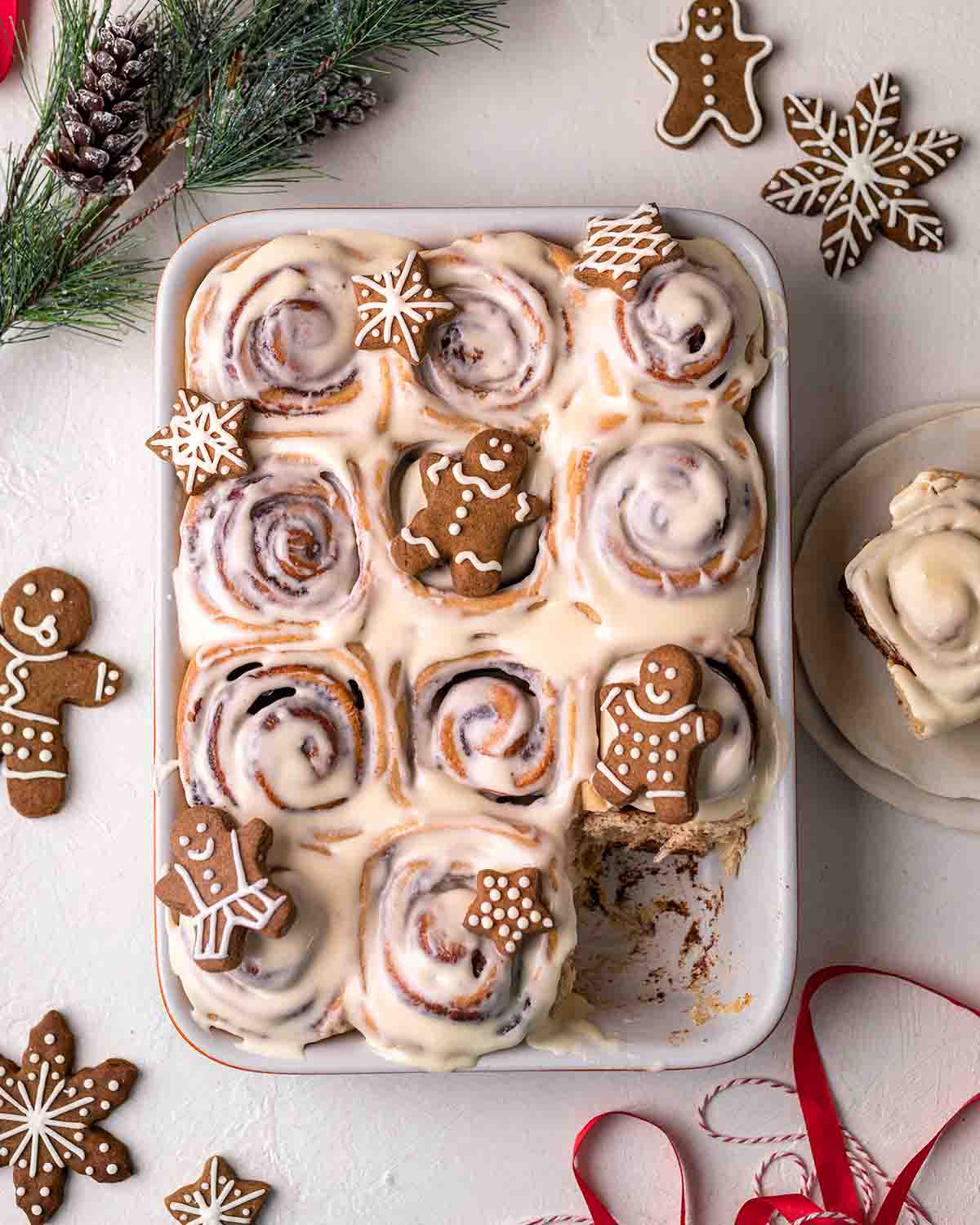
Why you'll love this recipe
TASTE/TEXTURE: These cinnamon rolls are pillowy, have LOTS of gingerbread flavor and melt in your mouth.
CROWD-PLEASER: Vegans and non-vegans alike LOVE these rolls! I often make these gingerbread rolls for my family's very non-vegan Christmas Day lunch and the whole tray of rolls is always demolished in minutes!
DIFFICULTY: Like any cinnamon roll or yeasted bread recipe, it takes some time to prepare this recipe. However, the results are definitely worth it!
Ingredients you'll need
This recipe combines a basic vegan brioche recipe with a generous gingerbread spice filling. You'll need:
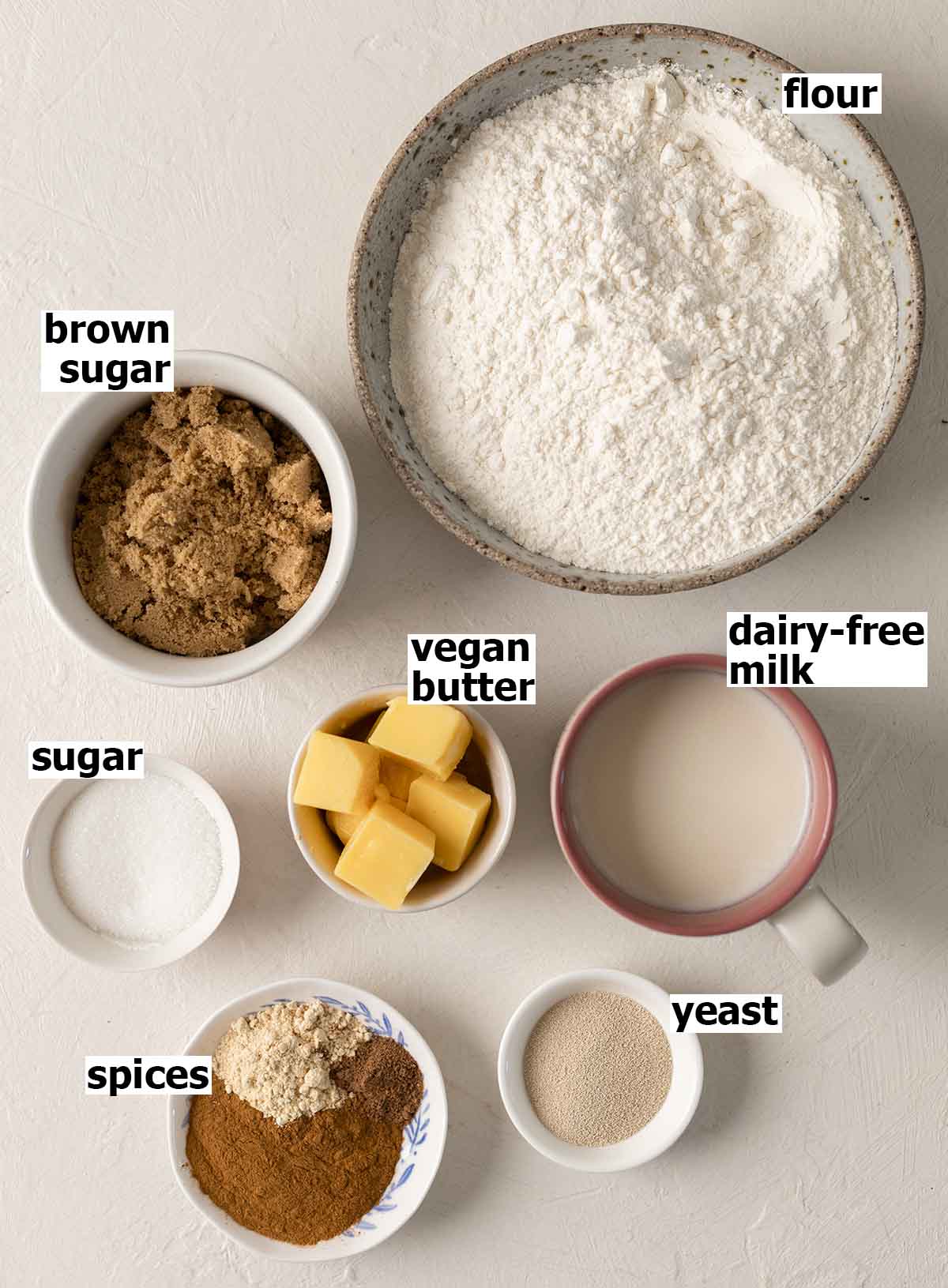
Notes about the ingredients
Bread flour or all-purpose flour. Bread flour creates stretchier and more 'bready' cinnamon rolls. In comparison, all-purpose flour makes slightly more cakey cinnamon rolls.
Vegan block butter for the cinnamon roll dough. Alternatively, you may use vegan spreadable butter (if you add a little more flour) or room-temperature coconut oil (if you add an extra pinch of salt for flavor).
Spices including ground cinnamon, ground ginger and nutmeg. We're adding a little cinnamon to the dough for extra flavor and using a lot of spices in the filling for a prominent gingerbread flavor.
The full list of ingredient quantities and instructions are in the gray recipe card at the bottom of this post.
Making the dough for the gingerbread rolls
Simply add all the ingredients to your stand mixer and knead for around 5 minutes until your dough is smooth and elastic. If you don't have a mixer, you can mix all the ingredients in a large bowl then transfer the dough to a lightly floured surface and knead until smooth.
The final dough should be soft, stretchy and slightly tacky. If there are any large cracks in your dough, add more milk and knead until it's soft. If the dough sticks to the side of the bowl, add more flour and continue kneading.
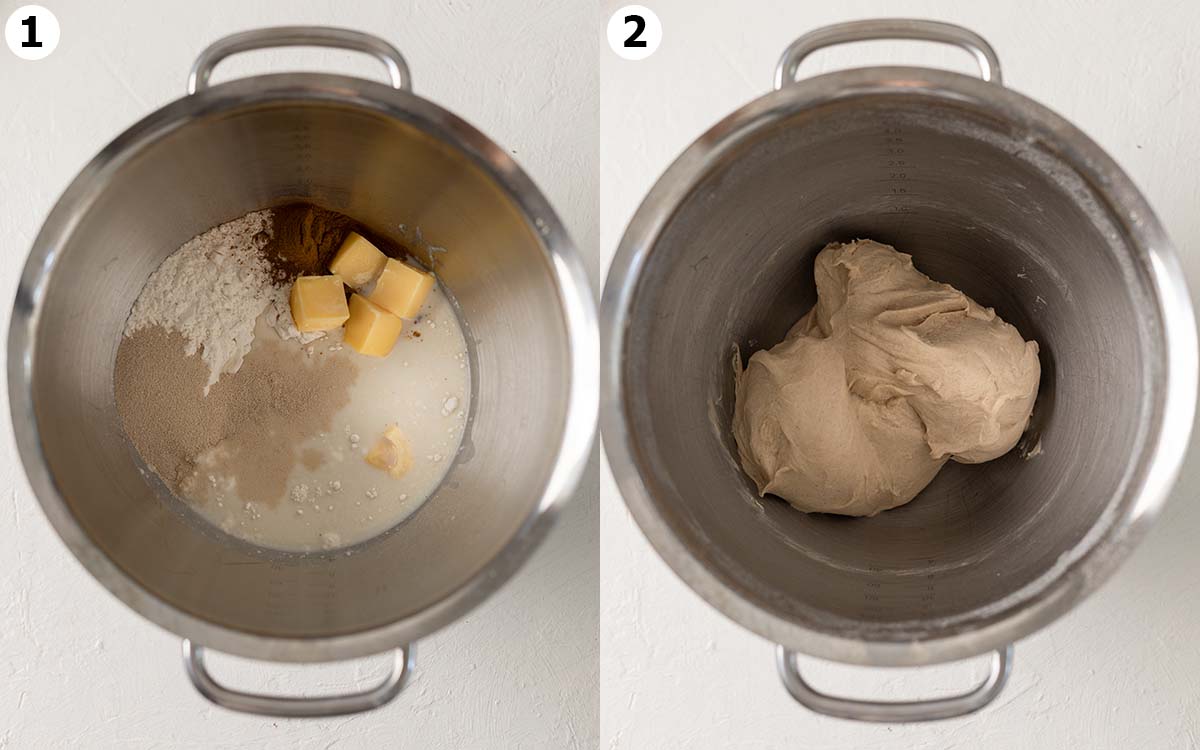
When you've finished kneading your dough, place it in a bowl, cover it with a tea towel or plastic wrap then place it in a WARM spot in your home.
The dough should double in size in an hour. If your home is a little cool, it may take a little longer for your dough to rise.
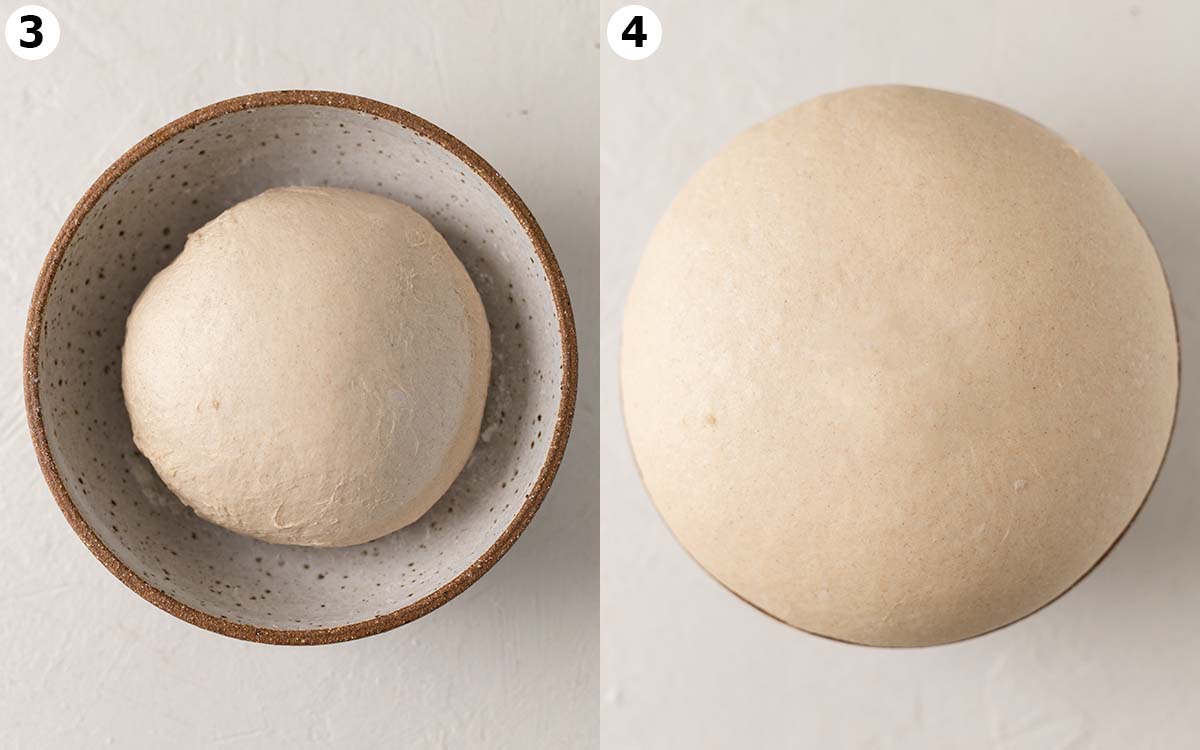
Tips for making the filling
The gingerbread cinnamon filling is extremely easy to make! However, I have a few tips:
- Make the filling during your dough's first rise.
- Make sure your butter is melted but not too hot. We don't want the dough to cook before it goes in the oven!
- It might look like there's not enough filling. It is enough! I've tried increasing the filling for this recipe but it oozes out and causes the cinnamon rolls to unravel even more.
Assembling your gingerbread cinnamon rolls
These vegan gingerbread rolls are assembled just like classic cinnamon rolls!
First, dust a clean surface with flour such as your kitchen bench. Then use a rolling pin to roll your dough into a rectangular shape. If you don't have a rolling pin, you can use a large glass jar. Your dough should be about 12 x 17 inches (30 x 45 cm) large.
Use a spatula to spread your gingerbread mixture on your dough. I spread the filling very close to the edge as it doesn't really ooze out when you roll it.
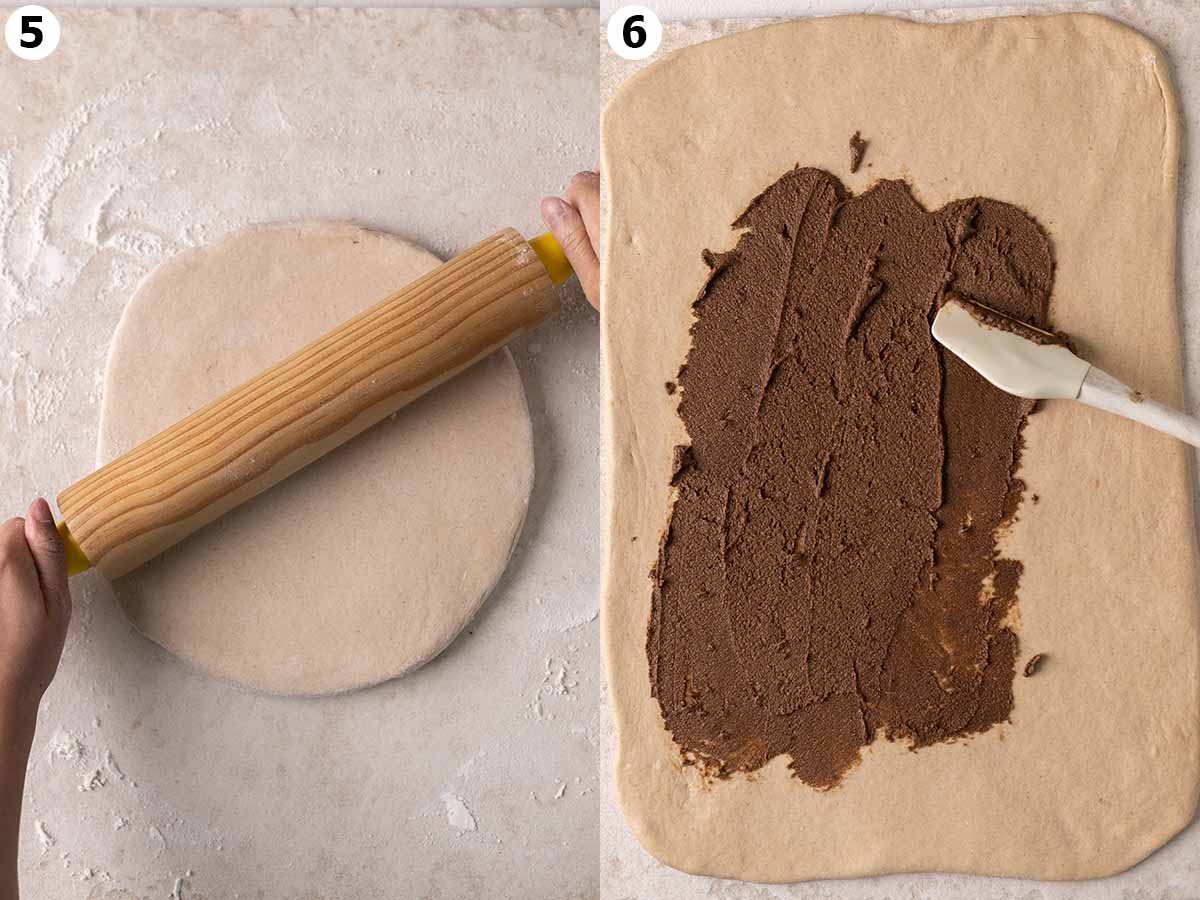
Carefully and tightly roll up your dough into a log shape, just like how you'd wrap a sandwich wrap.
For evenly sized gingerbread rolls, I recommend first scoring your log into quarters or 12 parts. Then use a very sharp knife or unflavored dental floss to slice individual cinnamon rolls.
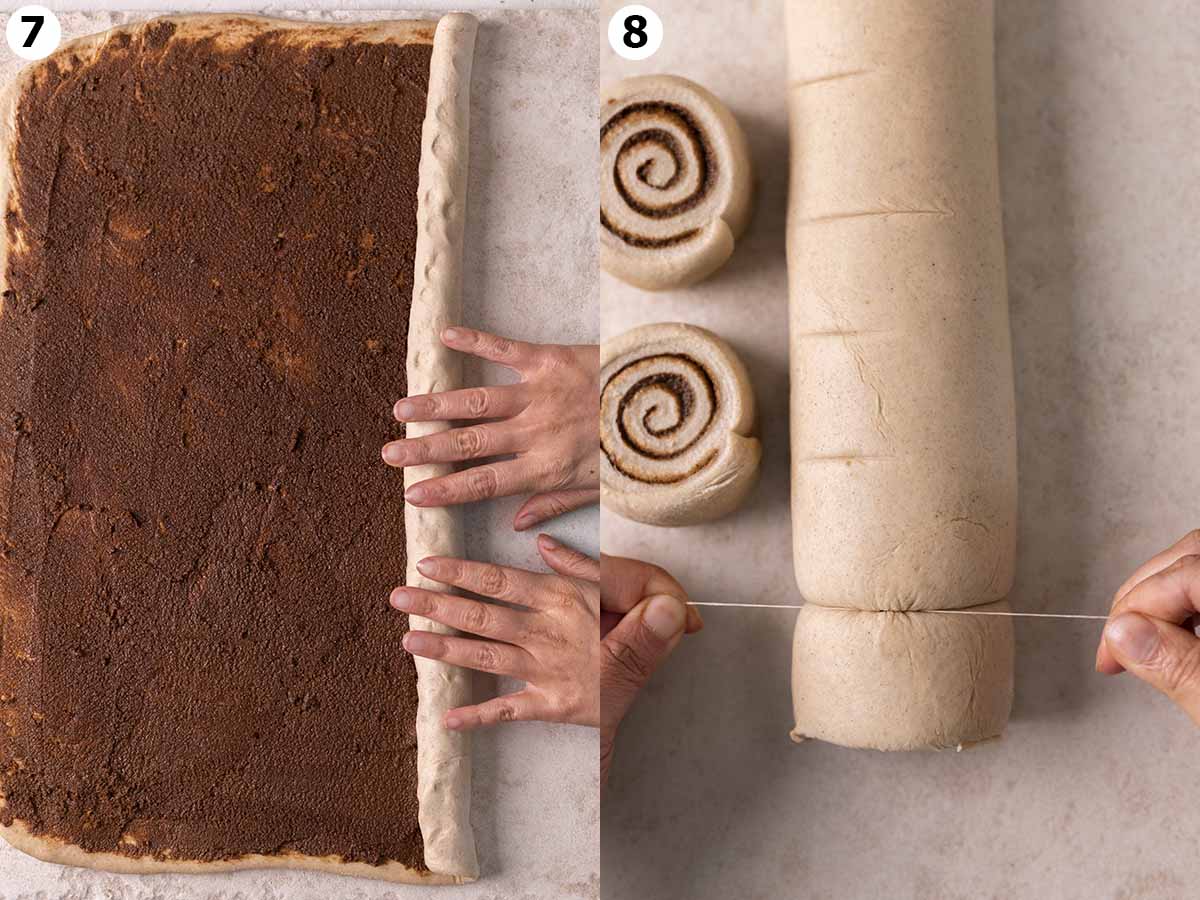
Second rise
Place the gingerbread rolls in a lined or greased baking pan and cover it with a tea towel. Once again, leave them in a WARM spot and allow them to rise.
The rolls are ready to bake when they're puffy again!
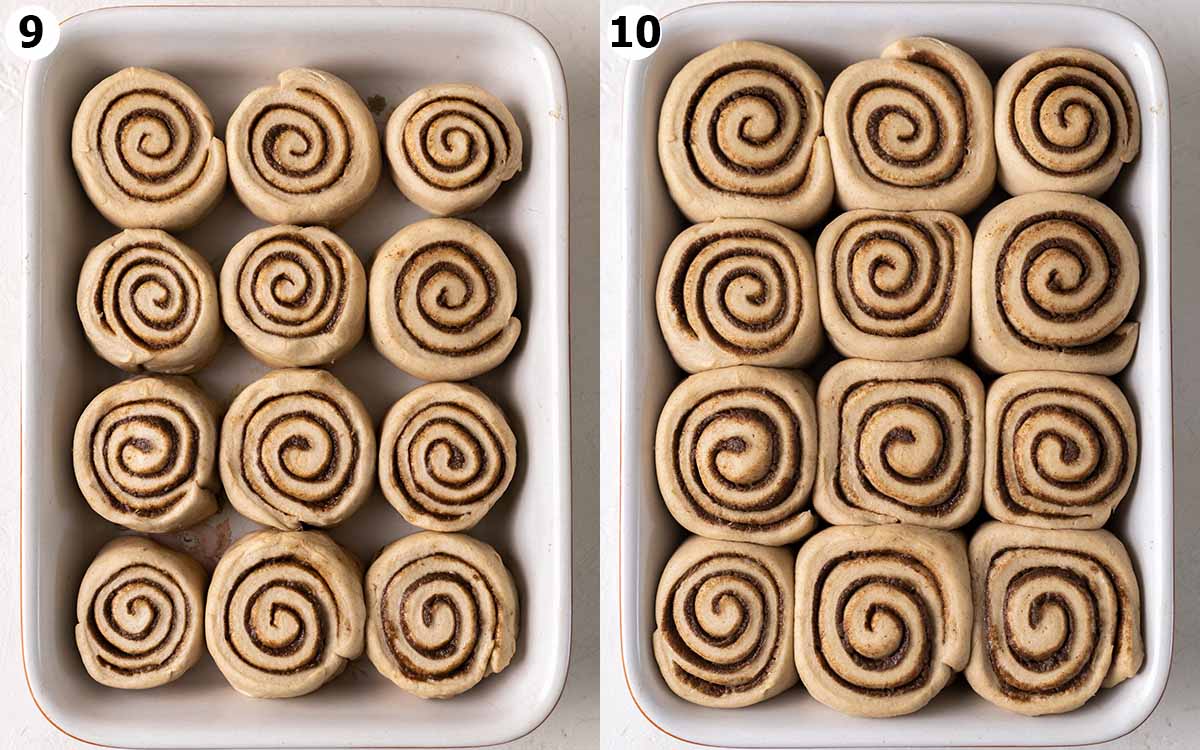
Baking and decorating the cinnamon rolls
The rolls are done baking when the rolls are evenly golden brown on top. If you press the side of a roll, it should feel a little firm and not squishy.
Another method is to insert a skewer or toothpick in one of the middle rolls and try to collect a very small piece of dough from the bottom. If the dough is raw, the rolls aren't ready. If the dough looks cooked, the rolls are ready!
I love frosting these rolls while they're still warm. It makes the cream cheese icing gooier and we can enjoy the rolls while they're fresh!
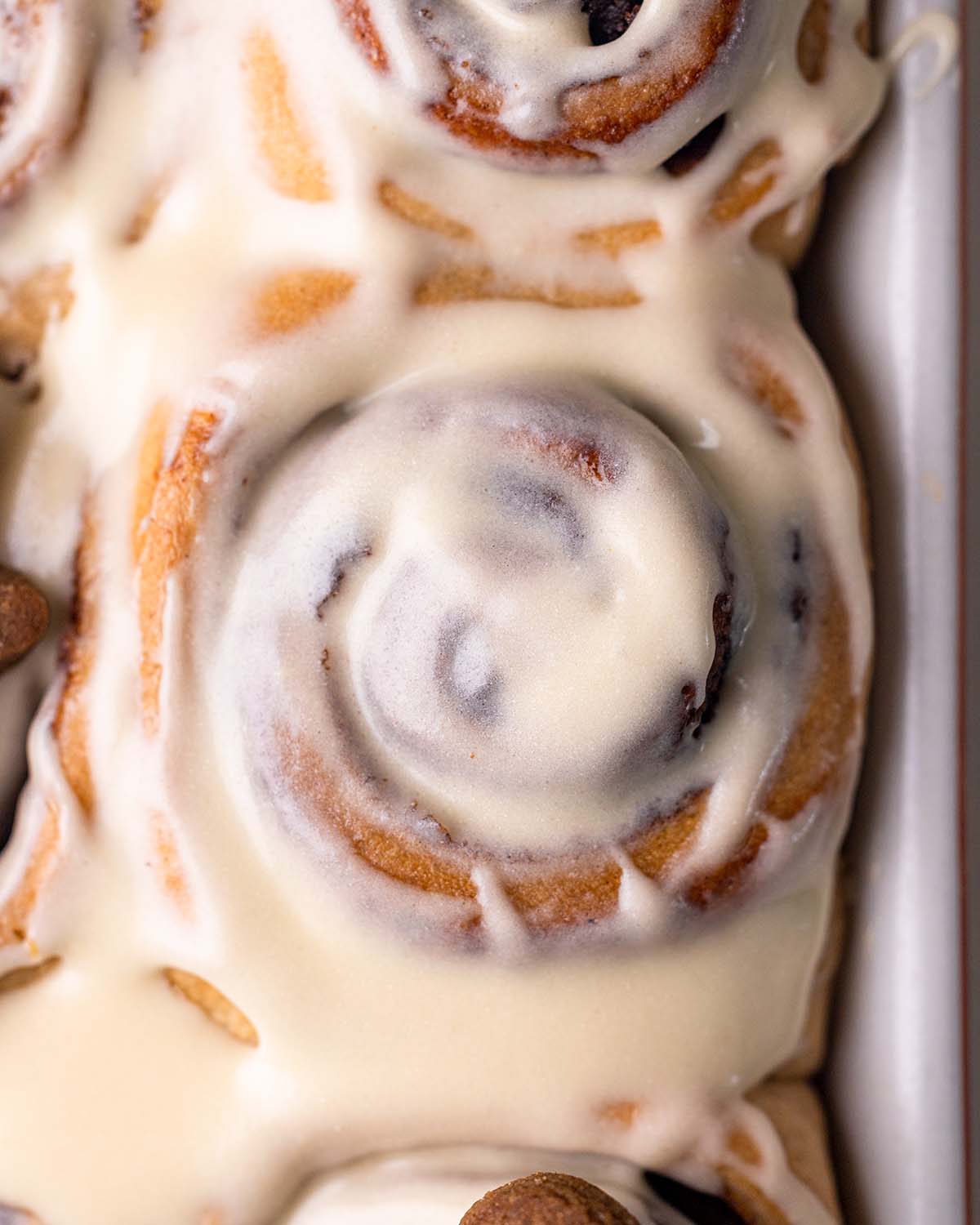
Making the gingerbread rolls in advance
These rolls can definitely be prepared beforehand. If you want to enjoy them on Christmas Day, you can start making them the day before! You can either:
- Chill the dough in the fridge during the first rise (before they are shaped). I recommend placing the dough in a large container as it will double in size in the fridge. The next day, when the dough is warm enough to handle, you can assemble the rolls. Luckily, chilled dough is easier to work with!
- Shape the rolls, place them in a baking tray and chill them during the second rise. On the day of serving, you can bake the rolls straight from the oven. They'll just take 5-10 minutes longer to bake.
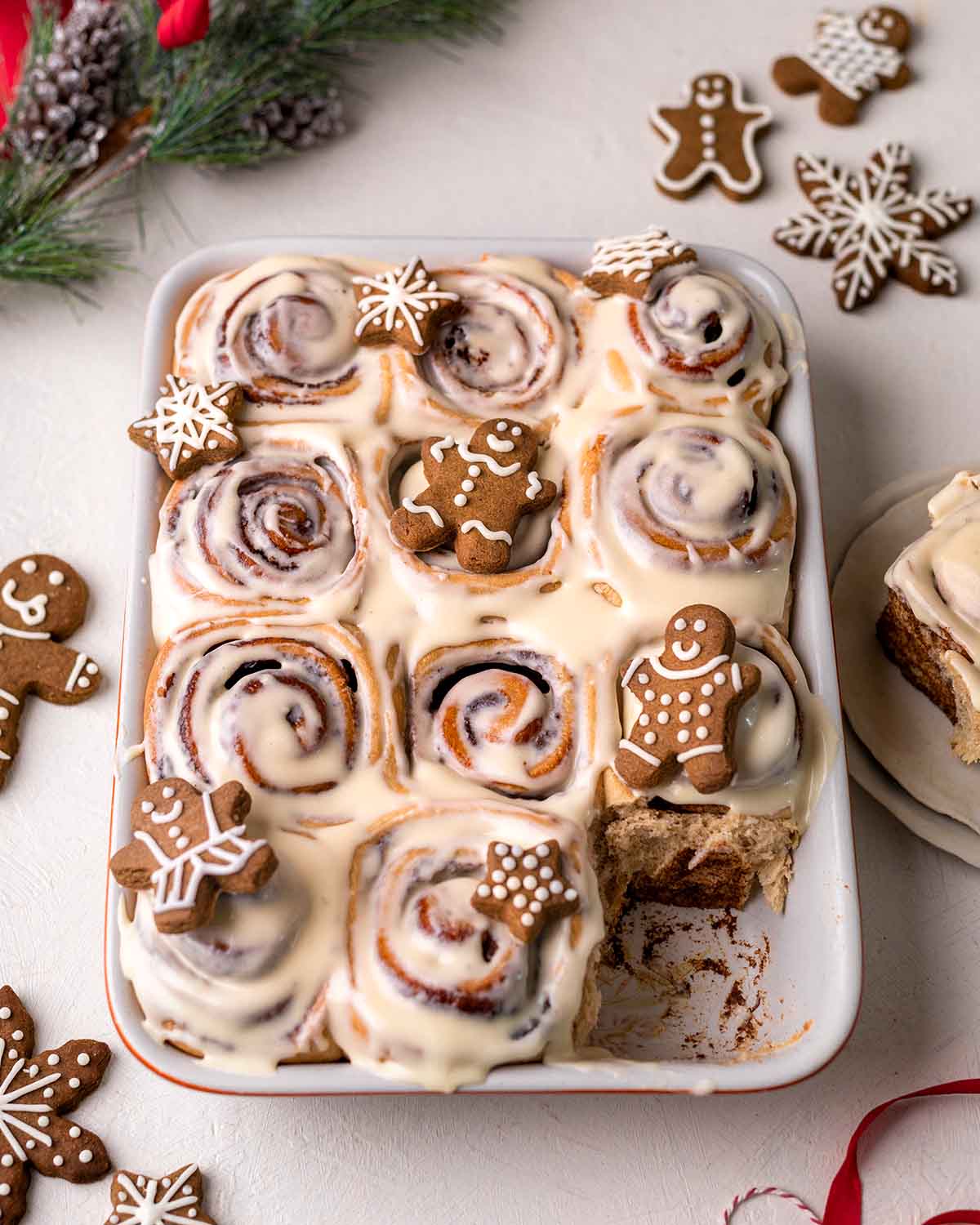
Troubleshooting cinnamon rolls
I've tested this recipe many times to ensure it's as foolproof as possible. However, like any dessert or bread recipe, there are so many variables!
TEMPERATURE: If your dough doesn't rise, move it into a WARMER spot in your home. King Arthur Baking says the best temperature to rest dough is 75°F to 78°F (24°C to 26°C). This is more important for enriched dough that contains butter as the butter needs to stay soft enough for the dough to rise.
DOUGH IS TOO DRY: If your dough is too dry at the kneading stage, simply add more liquid then knead it again. It's difficult to add moisture to the rolls once you've passed this stage.
DOUGH IS TOO SOFT: Soft dough makes delicious cinnamon rolls but it makes it more difficult to shape the rolls. If your dough is too soft, chill it in the fridge for at least 20 minutes.
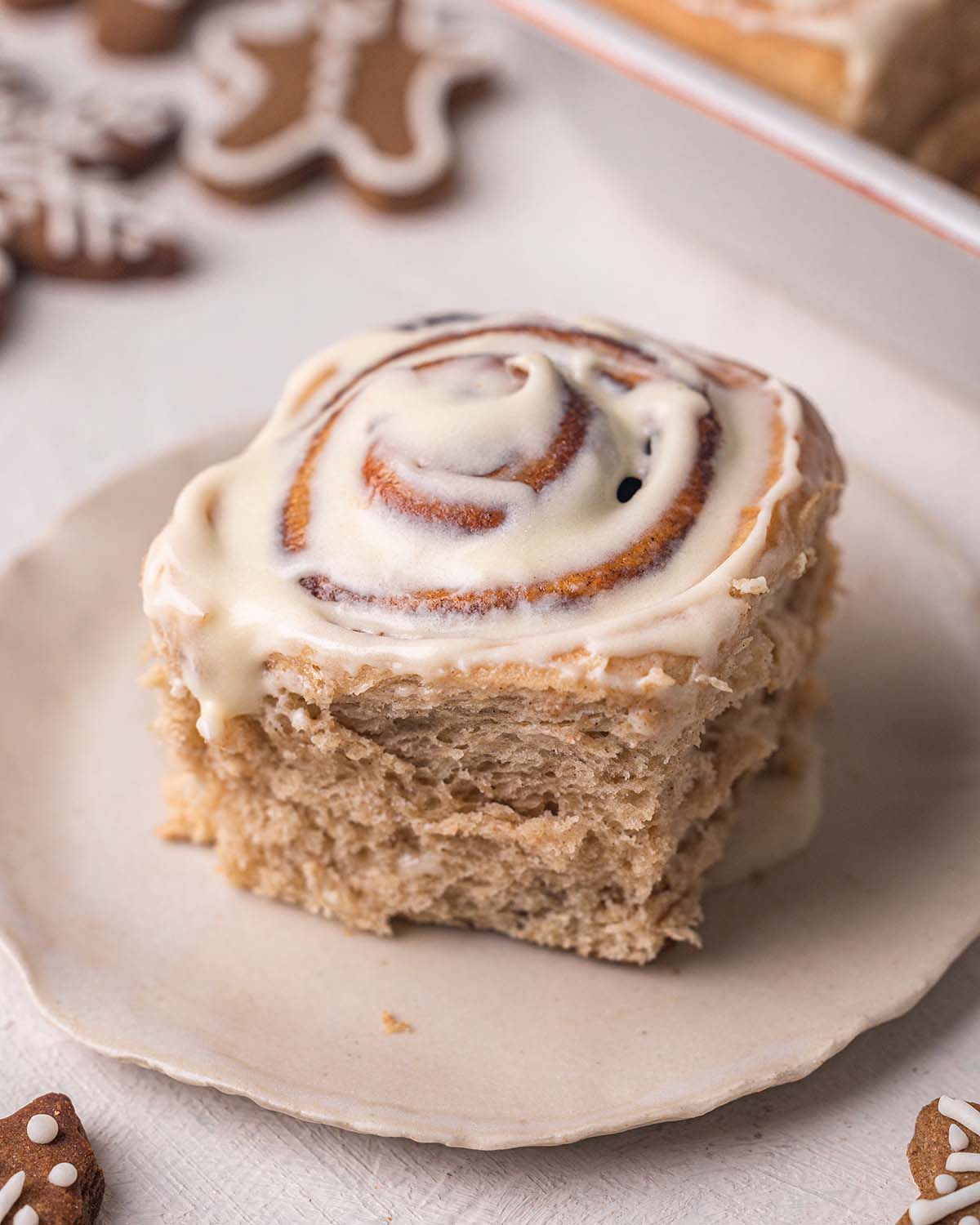
Expert Tips
To give the dough extra flavor, you may:
- Add ground ginger
- Replace sugar with 1 tablespoon of molasses
To give the filling extra flavor, you may add:
- Vanilla extract
- Dash of molasses
- ¼ teaspoon ground cloves
- Chopped pistachios
- Crumbled gingerbread cookies or even biscoff cookies
More Vegan Christmas recipes:
Follow Rainbow Nourishments on Instagram, Facebook, TikTok and Pinterest, and subscribe via email to receive all of our latest recipes!
Vegan Gingerbread Cinnamon Rolls
Ingredients
Gingerbread Cinnamon Rolls
- 3 ⅓ cups (415g) all-purpose plain flour, or bread flour plus more for dusting (note 1)
- 1 cup (250g) dairy-free milk, warm
- ½ cup (115g) vegan butter, room temperature (note 2)
- 3 tablespoons (40g) granulated sugar, brown sugar or coconut sugar
- 1 tablespoon (9g) instant dry yeast, (note 3)
- 2 teaspoons ground cinnamon, optional
- Pinch of salt, skip if using salted vegan butter
Filling
- ½ cup (95g) packed brown sugar, or coconut sugar
- ⅓ cup (75g) vegan butter, melted and cooled
- 2 tablespoons ground cinnamon
- 1 tablespoon ground ginger
- ½ teaspoon ground nutmeg
Cream Cheese Icing and decorations (note 4 for alternatives)
- ½ cup (120g or 4 oz) vegan cream cheese, room temperature
- 1 cup (100g) powdered sugar / icing sugar, or to taste
- 3 tablespoons (40g) vegan butter, room temperature
Gingerbread cookies
Instructions
Prepare the gingerbread roll dough:
- Add all the ingredients to a stand mixer with the dough hook attachment or a large mixing bowl. Knead for 5-10 minutes until the dough is smooth and elastic. Add a little more milk if the dough is too dry or a little more flour if the dough sticks to the bowl.
- Place the dough in a bowl and cover it with a tea towel. Leave the dough in a warm place for at least 1 hour or until the dough doubles in size. Alternatively, rest the dough in an airtight container in the fridge overnight.
Prepare the gingerbread cinnamon filling:
- Add all the ingredients to a small bowl. Mix until it forms a smooth paste and set aside.
Assemble the gingerbread rolls:
- Grease or line a baking pan with parchment paper. My pan was about 11 x 6 inches (28 x 15 cm) large but any similar-sized pan will work. You may use a larger baking pan for more spaced-out cinnamon rolls.
- Lightly dust a clean surface with flour. Roll out the dough into a rectangle about 12 x 17 inches (30 x 45 cm) large.
- Spread the gingerbread filling on the dough close to the edge.
- Starting from the long side, roll the dough into a tight log. Use a sharp knife or unflavored dental floss to cut out individual rolls from the log.
- Arrange the cinnamon rolls in your baking pan and cover them with a tea towel. Set aside your pan in a warm spot for at least 1 hour. The rolls are ready when they've grown by at least 50% and appear puffy.
Baking the gingerbread rolls:
- When your rolls are ready to bake, preheat the oven to 180°C (350°F).
- Bake the rolls in the oven for 20-25 minutes or until the surface is evenly golden brown. If you insert a toothpick in one of the middle rolls, there shouldn't be any raw dough on it.
Decorating and serving:
- While the rolls are baking, add all the cream cheese, sugar and butter to a bowl. Beat until combined and there are no lumps. For a thicker frosting, beat in more butter or chill the mixture.
- Allow the rolls to cool for 10 minutes then top with the icing. If desired, decorate with gingerbread cookies. Allow the rolls to cool further.
- The rolls are best eaten the day they are baked. Alternatively, store them in an airtight container at room temperature for 1 day or in the fridge for 1-2 days. Warm up leftovers before serving again.
Notes
- I haven't tested this recipe with gluten-free flour. However, readers have successfully made my other similar recipes using King Arthur's 1:1 flour.
- If using spreadable vegan butter, make sure it's chilled. You may also need to add more flour while kneading. You can also use softened coconut oil but add an extra pinch of salt, for flavor.
- Instant yeast doesn't need to be 'activated' beforehand. If you use another type of yeast, combine it with the milk from the recipe and a pinch of sugar beforehand. Wait until it bubbles then use it in the recipe.
-
If you don't have cream cheese, you make a simple vanilla buttercream from ½ cup (110g) vegan butter and 1-2 cups (100-200g) powdered sugar, to taste If you don't want to use powdered sugar, you can add 1 tablespoon of maple syrup and increase it, to taste.
Nutrition
This post was originally published in November 2019 but updated in November 2020.
This post may contain affiliate links. As an Amazon Associate, I may earn a small commission from qualifying purchases at no additional cost to you.
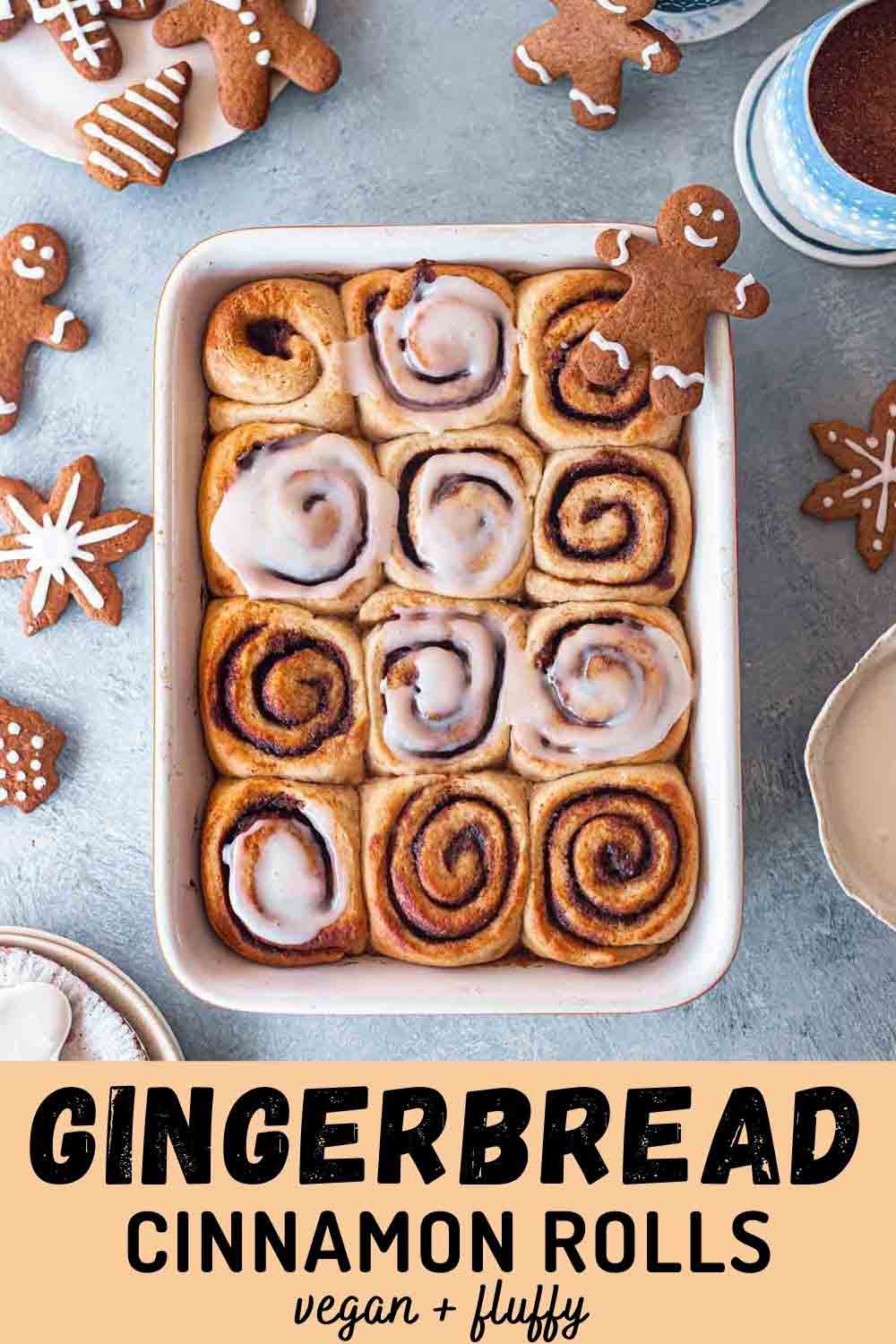




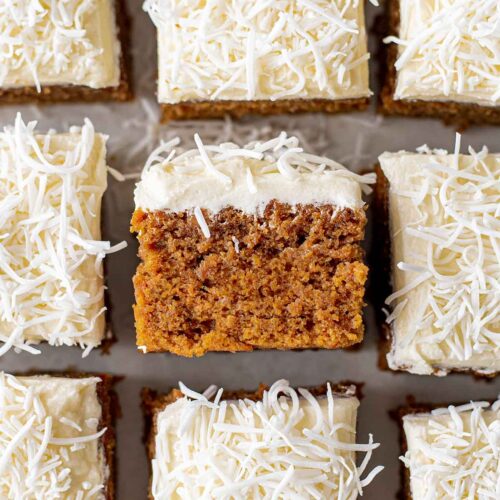
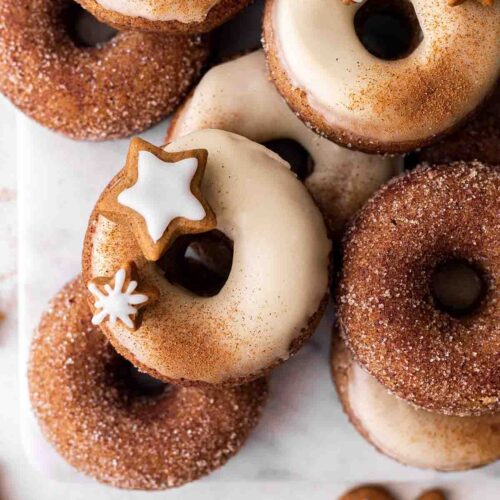

Hello
Can I substitute all purpose flour for 1:1all purpose gluten free flour?
Hi, it depends on the 1:1 flour! Readers have said that King Arthur's 1:1 flour has worked well for them.
Hello! I only have brown and white sugar, would either of these work in the dough?
Excited to make these! Can’t eat dairy or soy this holiday season so trying to make a replacement of our Christmas morning breakfast tradition.
Hey! Yes, brown and/or white sugar would be perfect for the dough :). I hope you enjoy these for Christmas and let me know how you go!
The recipe is very easy, quick and the risk free 🙂
The filling is scrumptious and makes the rolls soft and moist. They actually grow a lot in the oven so it’s important to give the space to do so.
My boyfriend said they are the best I’ve ever made and I agree, they are great, to eat and to bake 😛
Aw, that's so nice to hear! And thanks for your feedback too. It makes me want to make them again asap!
I love this recipe! So easy to follow especially with the step by step photos
Aw thanks so much Nara!
This is NOT A DRILL! BEST GINGERBREAD/CINNAMON ROLL recipe ever!
I will not use any other recipes from now on because this tasted so heavenly me and my boyfriend cant stop eating them.
The dough came together and shapes super easily so I think even first time bakers can make this without a problem.
Aw that's the loveliest feedback ever! I'm soo glad you and your boyfriend enjoyed these and found the process easy too! x
These are such a good cinnamon roll recipe!!!! My first time making them and what a TREAT!
I also tried her wreath but in a different flavour than given and it was also delicious. 🙂
Aw YAY, especially for your first time!! And glad you enjoyed the wreath recipe too! Thanks so much for your feedback xo
Okay! It was literally the BEST cinnamon rolls that i ever eaten!
Yes, ginger is very pronounced, but its "rich" taste is sweet and pleasant! You just have to do it in the winter at least once! You definitely will not regret it!
Aw I'm sooo happy to hear they're the best cinnamon rolls you've ever eaten! Thanks so much for taking the time to leave your feedback and I hope you and your family have a wonderful festive season 🙂
Hi Anthea!
Just want to share my experience in making vegan rolls.
In the dough, plant milk is not necessary, just use water. I prefer to use oil instead of vegan butter (more natural).
As a filling, I love to use your coconut caramel from your book. 🙂
Thanks for your feedback Eva! A few people used oil instead of butter in my previous scrolls recipe but said it affected the rising for them so I used only butter in this. You're welcome to use oil 🙂